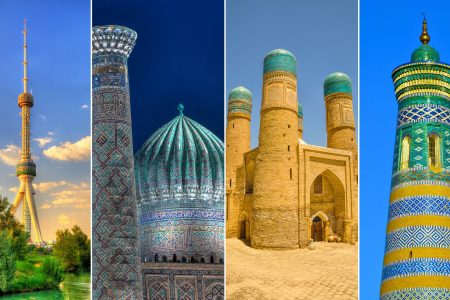9.7 million
Official: Tajik, Russian
Dushanbe
Borders: China, Turkmenistan, Afghanistan, Uzbekistan, Kyrgyzstan
Somoni (TJS)
Winter (Cold);
Summer (Dry and Hot)
Situated in the heart of Central Asia, Tajikistan offers a rich mosaic of population and culture. Tajiks constitute the majority ethnic group, accounting for approximately 80% of the population. They are of Persian origin and speak Tajik, a language related to Persian. Pamiris, an ethnic group residing mainly in the Pamir region, are predominantly mountain-dwellers with a distinct identity and culture influenced by Ismailism, a branch of Shia Islam. Other ethnic groups include Uzbeks, Kyrgyz, and Russians, contributing to the cultural diversity of the country.
Tajik is the official language of Tajikistan and belongs to the Indo-Iranian language group, being a variant of Persian. The Tajik language has evolved under the influence of various historical, cultural, and linguistic factors. Here are some key points regarding the language in Tajikistan: Tajik, also known as Tojikî in Tajik, shares similarities with Persian spoken in Iran and Afghanistan. However, regional peculiarities and lexical borrowings from Russian distinguish standard Tajik. During the Soviet period, Russian played a significant role in all aspects of life in Tajikistan, including education, administration, and business. This led to a substantial influence of Russian on the Tajik language, with the adoption of Russian terms into Tajik vocabulary. Russian is often used in official interactions, trade, and urban contexts. Before the Soviet period, Tajik was written in the Persian script. However, under Soviet influence, a version of the Cyrillic script was adopted to write Tajik. After gaining independence, Tajikistan reverted to the Persian alphabet. Education in Tajikistan is conducted in Tajik, but Russian is also taught as a mandatory subject. Universities offer programs in both languages. The question of preserving Tajik language and identity is significant, and efforts are underway to promote the use of Tajik in all aspects of daily life, encouraging literature and media in Tajik.
Exploration of the Geography and Landscapes of Tajikistan
Located in the heart of Central Asia, Tajikistan unveils itself as a geographical gem, offering landscapes of astonishing diversity, from snow-capped peaks to verdant valleys. Tajikistan is dominated by the spectacular mountain ranges of the Hindu Kush and the Pamir, the latter often referred to as “the roof of the world.” The Ismoil Somoni Peak, towering at over 7,400 meters, stands as the country’s highest point. These majestic mountains provide a perfect setting for adventure, with exceptional opportunities for climbing and trekking. “Roof of the World”: The Pamir, nicknamed the “roof of the world,” is an iconic region of Tajikistan. Its high plateaus are home to glacial valleys, crystalline lakes, and isolated villages. Lake Karakul, nestled in the heart of the Pamir, dazzles with its deep blue waters reflecting the surrounding peaks. Tajikistan boasts verdant valleys that beautifully contrast with the snow-capped summits. The Fann Valley, for instance, captivates with its turquoise lakes, dense forests, and green meadows. These valleys often serve as the stage for outdoor activities such as hiking, horseback riding, and immersing in nomadic life. Lake Sarez, Hidden Treasure: In the heart of the Pamir Mountains, Lake Sarez nestles, created by a landslide in the early 20th century. Surrounded by imposing peaks, this lake offers a breathtaking spectacle and stands as an impressive example of nature’s power. Sculpted by the Amu Darya River, the Oxus Canyon reveals extraordinary rock formations. The red and ochre hues of the walls narrate the fascinating geological history of this region. Tajikistan presents climatic diversity, from scorching deserts to snow-covered peaks. Valleys enjoy a temperate climate, while mountainous areas experience rigorous winters. This diversity creates unique ecosystems, housing a variety of flora and fauna.
The ancient Silk Roads traverse Tajikistan, leaving behind historical remnants. The cities of Khujand, Ispisar, and Penjikent unveil archaeological treasures testifying to the historical significance of the region. Tajikistan emerges as a must-visit destination for nature and adventure enthusiasts. Its imposing mountains, picturesque valleys, and rich cultural heritage make it a place where geography and history harmoniously converge, offering a unique experience to intrepid travelers.
At the Crossroads of Mountains and Culture
Tajikistan, a lesser-known gem in Central Asia, is gradually opening up to the world as a tourist destination offering a unique adventure blending breathtaking mountain landscapes, a rich cultural heritage, and warm hospitality. Let’s explore what Tajikistan has to offer to intrepid travelers.
At the heart of the Tajik experience are the Pamir and Tian Shan mountains, offering breathtaking alpine panoramas. Trekking and mountaineering enthusiasts will find a paradise of adventures here, with Ismoil Somoni Peak, the country’s highest summit, and the Wakhan Corridor providing captivating routes. Tajikistan was once a major crossroads on the Silk Road, and this history unfolds through ancient cities such as Khujand and Ispisar. Elaborate mausoleums, bustling markets, and cobbled streets tell tales of flourishing trade and cultural crossroads. The country is dotted with stunning high-altitude lakes, including Iskanderkul and Sarez. These crystal-clear expanses offer peaceful retreats amidst the mountains and are venues for water activities and picturesque picnics.
Meet Tajik nomadic communities and discover their pastoral way of life. Yurts scattered in the Pamir valleys provide an authentic experience, allowing visitors to engage in local customs and savor traditional cuisine. Explore cultural riches in Dushanbe, the capital, with its museums, markets, and modern monuments. Festivals, such as Navruz, provide immersion in musical traditions, dance, and gastronomy.
Tajikistan is committed to sustainable tourism with a particular focus on preserving its unique ecosystems. National parks, like the Pamir National Park, enable travelers to experience the region’s preserved biodiversity. Tajik hospitality is legendary. Visitors are often invited to share a meal, participate in tea ceremonies, and exchange stories with locals. These authentic interactions leave lasting memories. Roads wind through spectacular valleys, offering car or bike journeys that are adventures in themselves. The Ak-Baital Pass, one of the world’s highest, provides breathtaking views of the Pamir.
The Shohdara Plateau, with its observatory, attracts astronomy enthusiasts. Starry nights at the top of the world are an unforgettable experience. Indulge in the delights of Tajik cuisine, with dishes like plov and various bread variations, often shared during generous hospitality.
Tajikistan offers an authentic escape for travelers seeking adventure, culture, and unique landscapes. Its towering mountains, ancient cities, and the warm welcome of the Tajiks make it a destination etched in the hearts of those who discover it.
Discovering Tajikistan: Unveiling Hidden Gems
Tajikistan, with its diverse landscapes and cultures, offers an endless adventure for curious travelers. Each destination reveals a unique facet of this Central Asian gem.



